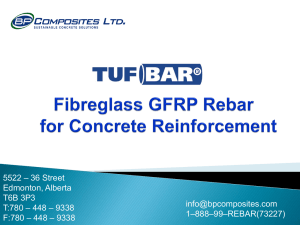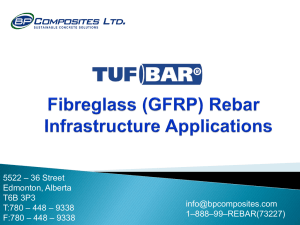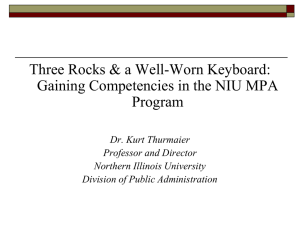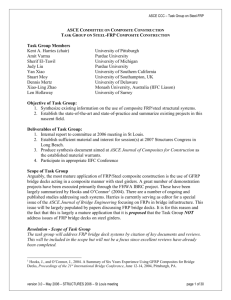GFRP Engineering (Click to Download)
advertisement
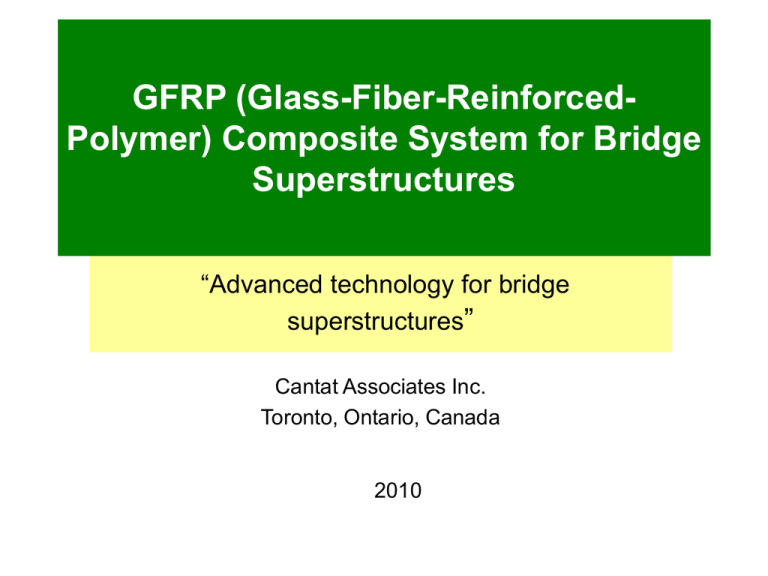
GFRP (Glass-Fiber-ReinforcedPolymer) Composite System for Bridge Superstructures “Advanced technology for bridge superstructures” Cantat Associates Inc. Toronto, Ontario, Canada 2010 1. How did it happen? As it is known, the actual lifespan for steel, reinforced concrete and steel-reinforced concrete SS’s everywhere in the world is no longer than 35 to 50 years, which is much shorter than Canadian, American, or European Bridge Design Code requirements. The causes for such a dramatic mismatch, in our analysis, are: 1. Acid rains, occurring with increasing frequency over the last several decades. 2. De-icing salts widely used to prevent traffic sliding. 3. Contaminating debris, increasingly being brought on deck wearing surface by truck wheels. 4. Damage to structural elements due to fatigue. The cause for such a short lifespan cannot be blamed on the growing weight of heavy trucks. In our opinion during the last 60 years, the average weight of heavy trucks has increased by no more than 20%. Within the Bridge Design Codes, this problem is solved by using conditional live loads (i.e. conditional heavy trucks, much heavier than real trucks) and a significant magnitude of live load factor in calculations, as well as much better than theoretical live load redistribution in real superstructures. The precise space calculations of a superstructure’s cross-sections and test results are confirming this statement theoretically as well as practically. To summarize: the unanticipated changes in environment and material properties over time are the primary causes for dramatic reduction in the service life of bridges. The secondary cause in the SS’s degradation is insufficient funding for proper maintenance. 2. What to do? The obvious conclusion for the Engineers was to seek alternatives to the materials conventionally used in bridge construction and rehabilitation. The solution would involve using materials that are not vulnerable to environmental damage and would increase service life, which means durability of bridge SS’s. On the other hand, the life cycle and maintenance costs would have to be competitive with traditional materials, because of the limited resources available for maintaining those bridges. Such alternative material was found. It is FRP (Fiber-Reinforced-Polymer)-composite product. In the mid 1930s as a part of experiment FRP was used for a boat hulls. From that point on and during the following 50 years, FRP-composite was used in marine, chemical processing, aerospace, for military items and transportation. Now, the worldwide attention is focusing on the opportunities offered by structural composites and structural industry. Composite FRP material is formed by using high strength artificial fibers (for example E-Glass, Carbon-Fibers, Basalt-Fibers and so on) and Resin (vinyl-ester, polyester and Epoxy) and offers many advantages: • • It is very strong and durable material, not sensitive to environment; It is much lighter than concrete or steel. According to Canadian official information, reinforced concrete and steelreinforced concrete structures during their lifetime of 35 to 45 years required an additional investment for their maintenance and rehabilitation of at least 40-50% of their initial construction costs. FRP-composite structures on the other hand do not require maintenance, or require minimal investment for painting of their open surfaces. There are three main methods for production of composite structures: Molding (mostly for small structural elements); Pultrusion (mostly for extensive elements, relatively with conditionally small cross-sections); Infusion (mostly for big structural elements). Cantat Associates Inc. selected GFRP composite material using infusion method for production, high strength E-Glass Fiber and Epoxy Resin. 3. How did we solve it? GFRP-composite system for bridge superstructures To meet time and situation challenges, Cantat Associates Inc. have developed a composite system for bridge SS’s in which steel, wood and GFRP are working together. Steel and wood are totally encapsulated by GFRP casing and are protected against corrosion and degradation. In our R&D we tested thousands GFRP samples based mostly on American Standards ASTM: Average Statistical test result Taken in consideration for design - Tensile strength and 1,000 MPa 800 MPa corresponding Modulus of Elasticity 45,000 MPa 35,000 MPa - Compression strength and 900 MPa 700 MPa corresponding Modulus of Elasticity 42,000 MPa 35,000 MPa - Flexural strength and 1,000 MPa 800 MPa Modulus of Elasticity 46,000 MPa 35,000 MPa - Shear strength 50 MPa 20 MPa Shear Modulus 3,600 MPa 2,400 MPa - Coefficient of linear Expansion 0.000011 / °C 0.000011 /°C - Acceptable max value of the strain in GFRP (ULS – see § 13.11.2.3, CHBDS) - - Strains changes in GFRP equal strain changes in adjacent wood or steel (SLS – see § 16.11.2.2) - 0.005 < [0.006] - - Durability test (UV-test with changing “t” from 130°C to -130°C) - 5600 cycles – lost 1 micron ~ 150 year ~ 150 year - Mass density 2,050 kg/m3 2,050 kg/m3 • • Glue-nailed Laminated timber core shell conform to CAN/CSA-0122 (Spruce-Pine-Fir selected wood or #1) Plywood shall be CANPly Exterior Canadian Softwood Plywood (CSP) certified by CSA-0151 (thickness shall not be less than 25.5 mm, number of plies shall not be more than 9, not less than 7) From year 2002 up until today we made a long way to get considerably adjusted GFRP material: • • • • To find the most efficient sections of our Hybrid GFRP composite structures; To efficiently include GFRP composite deck in combine operation with steel girders; To elaborate efficient details for deck fixation, to steel girders, barriers, the deck fixation to the steel frame; To attach elements of the deck to each other We already tested in full size GFRP-wooden composite beams 3m in length. We designed, tested and installed nine different superstructures from 11m simple span up to 90m one span, including a Hybrid – GFRPcomposite deck and a Skew bridge. All those bridges had been designed and successfully used for the last 4-7 years under Truck Live Load 625 kN, one of those bridges is a pedestrian bridge over HWY 10, with continuous SS’s (scheme 24+36+24m). Another bridge was installed under a highway in Nova Scotia. The main advantages of our GFRPcomposite SS’s are: 1. Extremely long expected durability: over 100 years 2. Light weight: increases superstructure's capacity or reduces volume of the material(s) (e.g. steel) 3. Quick installation: usually installed and opened to public traffic in 2-3 hours 4. Environment-friendly: prefabricated, eliminating scaffolding and contaminating debris 5. Maintenance free life cycle: not sensitive to the environment does not corrode or deteriorate and only requires painting of deck (superstructure) open surfaces once in a decade 6. Year-round construction: suitable for construction in both cold- and warm-weather conditions 7. Final costs now is approximately 5-10% lower than steel or reinforcedconcrete SS’s and no costs or minimal costs for their maintenance The primary reason for using GFRP-composite SS’s is their unique long-term durability. There are no alternatives to this product anywhere in the world. The Ministries of Transportation of both Ontario and Nova Scotia have already recognized and adopted this system. COMPARISON OF SUPERSTRUCTURES FOR DIFFERENT MATERIALS CON DYNAMIC LOAD ALLOWANCE BENDING MOMENT DECK mm THICKNESS REQUIRED FATIGUE STRESSES IN DECK CASING STEEL - R. CONCRETE AND REINFORCED CONCTETE SUPERSTRUCTURES STEEL GIRDERS AND GFRP COMPOSITE DECK RESULTS 1.25 1.30 1.17 1.21 6.5% LESS 7.4% LESS 100% 88% 12% LESS 225 204 9.4% LESS REQUIRE DESIGN EVALUATION NOT REQUIRED - BENEFITS Environmental assessment simplified Lighter deck and girders + smaller dynamic load allowance reduce project costs Superstructure height, reduces project costs Better navigable water fit, reduces project costs BENEFIT CHBDC does not require fatigue analysis when stresses in material are less than 30%, it means – less number of restrictions shall be used in design of GFRP composite superstructures RC – steel structures require fatigue analysis Tests conducted • Type of tests conducted – coupons – Beam sections, – Deck sections, – Results: MOE, Shear, etc. • Testing conducted by – – – – • Cantat Associates Inc. University of Western Ontario Triodem Integrity Testing Lab Results – Product in conformance CHBDC CL 625 Truck Loading Testing and Theoretical Load-D eflection Relationship of Bolton Bridge Span structure ( Support D eflection are Subtracted) LOA DING BLOCKS 30 min 48 (22.28) A DI #1 DI #1 44 (25.30) DI #5 DI #3 (22.15) 22.26 D I #5 25.29 33.55 D #6 DI #6 DI #4 3120 20.57 3120 DI #7 (15.70) Span Struc ture Tes ting. Sc heme of Dial Indic ators 600 24 (13.91) D #2 D #1 32 C L 600 (14.09) 13.91 D #3 SP AN = 15800 28 15.70 ( DI #6 27.45 18.16 (13.41) 14.09 21.35 (11.87) 11.76 13.31 DI #5 18.3 DI #7 SE CT IO N A 7.77 16 8.53 12.2 19.5 mm 1/800L DI #2 20 7.77 12 3.95 8 4.07 Note: The repeated res ults s how n in brac kets 6.1 3.95 Service Study LL x (Dynamic Load Allowance) 11.86 4380 30 min D #5 3120 (20.60) (18.17) 18.16 D #4 3120 30 min (18.17 ) 20 min Service Study LL x (Dynamic Load Allowance) x 1.297 DI #2 36 D #5 D #4 D #3 DI #7 D #2 40 D #1 4380 22.14 30 min D I #6 20 min DIAL INDICATOR #5 DIAL INDICATOR #6 DIAL INDICATOR #7 4 THEORETICAL DEFLECTION. 0 0 0.00 0.00 0 2.5 5 7.5 10 12.5 15 17.5 20 22.5 25 27.5 30 32.5 35 DISPLA CEMENT Test every bridge Load at plant Load at site See page 194 CHBDC and provide test report to owner 9.13m long x 8.7m wide Typical Prefab bridge panel Typical Deck to steel girder connection Typical Diaphragm Connection Typical Panel to Panel Connection Stage 1 Stage 2 Stage 3 Contact information: Cantat Associates Inc. Toronto, Ontario, Canada Fax: Alexander Zevin - +1 (416) 505-7139 Arie Prilik - +1 (647) 500-2441 Danny Golnik - +1 (416) 836-4455 647-436-1844 E-mail: cantat@rogers.com dgolnik@cantat-associates.com


